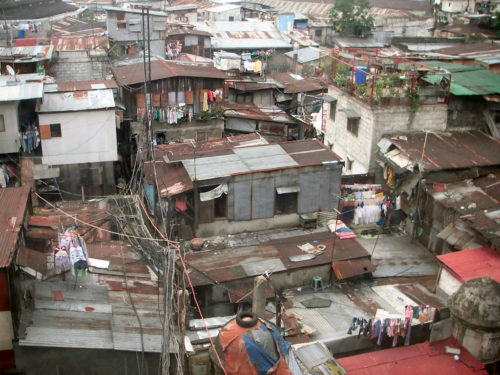Is There Any Reason for Trying to Help Haiti?
by David Sims
IT DOESN’T take an earthquake — not where Haiti is concerned. It has received billions of dollars from America, from Canada and from Europe in foreign aid over the years. America rebuilt Haiti’s entire economy and national infrastructure three times during the 20th century, but each time the improvements were destroyed not long after the US Marines had gone back home.
In the 18th century Haiti, then called San Domingue and ruled by the French, was the most prosperous colony in the New World. Its fertile soil produced an abundance of crops and drew thousands of French settlers. African slaves were imported to help with the work. So rich was its soil that San Domingue’s agricultural product exceeded, for a time, that of all thirteen of the original English-American colonies, combined. In the late 1700s, as an outgrowth of the French Revolution, the slaves in Haiti were incited to revolt, and they did — murdering every French man, woman and child. They took over government, changed the name of the country, and declared themselves a republic. What had been the richest colony in the New World quickly sank into poverty. The roads and cities built by the French fell into ruin. The “republic” of Haiti was governed by a mixture of violent anarchy and bloody despotism, which took the place of French law and order.
In 1915, after an especially chaotic period, U.S. Marines were sent into Haiti to halt domestic unrest. They were in Haiti for 19 years, during which they not only enforced governmental stability, but they also built schools and hospitals, and more than 1000 miles of paved roads with 210 bridges. (The Haitians did not build these things themselves.) The U.S. government trained Haitian teachers and doctors at the expense of US taxpayers. America gave the Haitians a chance for a fresh start. But as soon as the U.S. Marines pulled out in 1934, Haiti sank again, like a rock that had been brought briefly to the surface of the water and then let go. Everything the Americans had built for them was scavenged to pieces, destroyed by arson or by vandalism, or allowed to rot through neglect, until only ruins were left.
The same thing happened again in 1958. The US Marines went in and rebuilt Haiti’s infrastructure and got its economy going again, at a cost to US taxpayers of hundreds of millions of dollars. They rebuilt the roads and the bridges, the schools and the hospitals, plus some electric power plants and a modern telephone system. When the Marines left, Haiti once again fell apart due to internal corruption, domestic unrest, and native indolence.
And it happened again in 1994. The same foolishness. The same result.
A recent news editorial described Haiti’s problems, like this: “…though the Haitians and the UN are officially in charge of this crisis, a new reality has dawned: only a full-scale army can lift Haiti off its knees.” Buddy, that reality has dawned already several times in the past, but no matter how many times Americans get taught “The Lesson of Haiti,” they quickly forget and so repeat the mistakes of history. Anyone who has done his homework knows that Haiti will collapse once again into poverty and oscillating anarcho-despotism just as soon as the occupying army that helped them for a while leaves the country.
Haiti is the poorest country in the Americas, with a national income of about $2 per person per day. A historical study of comparative social and economic indicators shows that Haiti consistently fails to develop by even so much as other poor countries do. Foreign aid constitutes about 40% of Haiti’s national budget. The largest donor countries are the United States, Canada, and the European Union. In September 2009, Haiti met the conditions set out by the IMF and World Bank’s Heavily Indebted Poor Countries program, qualifying it for cancellation of its external debt. Since the earthquake of January 2010, the IMF has agreed to loan Haiti more hundreds of millions of dollars, which will also vanish down that black hole and accomplish nothing important, and which will likewise never be repaid, and so all the rest of the world’s credit users will be required to pay higher interest rates.
There is apparently no limit on how much wealth Haiti can cause to disappear.
In 1925, Haiti was a heavily forested country, with trees and vegetation covering the lands and mountainous regions. Since then, the population has cut down 98.5% of its original forest cover, mostly for firewood (cooking), and in the process has destroyed fertile farmland soils, contributing to desertification. The once peerless topsoil of the former San Domingue has washed into the sea, gone forever. In satellite photos, you can see where the Haiti/Dominican Republic border is because the latter still has trees, whereas the former is bare dirt. Besides the destruction of farmland through soil erosion, deforestation has caused periodic flooding. For the past decade, American volunteers have planted about six million saplings in Haiti each year. During that same period, the Haitians have cut down 25-30 million mature trees each year. But this trend will end, since the Haitians may cut down their very last fully grown tree this year.
Haitian politics are violent. The long history of oppression by native dictators, such as François Duvalier, has markedly affected the nation. But the event that really destroyed Haiti was its own founding revolution, in which every person with the honesty, the good will, and the competence to have kept the island country prosperous and politically stable were murdered. According to the Corruption Perceptions Index (CPI), Haiti has a spectacularly high level of corruption — high enough to be comical if it weren’t real. Significant amounts of money collected for the betterment of the commonweal are routinely misdirected toward the sole benefit of those in power, a fact that has sparked uprisings in Haiti in the past.
US Representative Porter Goss of Florida (and former director of the CIA) says of the billions of dollars in US foreign aid, “We’ve been ripped off in Haiti and I don’t see why we should put more money into it. There’s so much corruption that the only way to make sure aid gets to the people is to fly down there yourself with some food, hand it to a Haitian, and watch him eat it in your presence.”
Nearly all Haitian leaders, however they were styled, have been Voodooists as well as corrupt politicians. A partial exception to that rule was Fabre-Nicholas Geffrard, Haitian president from 1859-67, during the first three years of his tenure. He tried to imitate the old French ways to recover some of the lost prosperity of San Domingue. However, Geffrard became corrupt like all the other Haitian bosses, succumbing to the usual financial temptations beginning in 1862, although he apparently was never a Voodooist.
Haiti is said to be a largely Christian country, with Roman Catholicism supposedly professed by 80% of Haitians. That is, however, a well-publicized myth. Haitian Voodoo, a variant of African Voodoo, is practiced by about half the population. In fact, Christianity isn’t significantly in practice in Haiti. What is mistaken for Christianity is essentially Voodoo with a Catholic veneer. Voodoo is polytheistic with a hierarchical assemblage of deities, and the basic difference between the African and Haitian versions of Voodoo is that, in the latter, the Voodoo deities are sometimes associated with the names of Catholic saints. One of the most powerful of these deities, or loas, is DanbhalaWedo, who is believed to be represented in our mundane world by snakes. Voodoo is a combination of snake-worship and spirit possession. Its “high ceremonies” sometimes involve human sacrifice, usually a child, and cannibalism.
Nearly half the causes of deaths have been attributed to HIV/AIDS and other infectious diseases. Approximately 8% of Haiti’s adult population is infected with HIV. Intestinal parasites are common. Tuberculosis is about ten times more common in Haiti than in other Latin American countries. Some 30000 people in Haiti suffer each year from malaria.
Much of Haiti, except for a few reserved areas which are carefully kept picturesque (and uninhabited), resembles a junk yard, which is additionally sometimes stripped of vegetation. Americans, and others, have tried repeatedly and at great expense to lift Haitians out of poverty; it hasn’t worked. It won’t work.
* * *
Source: David Sims







The population of neighbouring Dominican Republic, which has a MUCH HIGHER level of White Genes in their blood, have a totally different mentality, compared to Haitians! They were intelligent enough, thanks to their White Genes, to preserve their Forests and Environment, while making of the Dominican Republic a quite successful, inded thriving Tourism-oriented Nation, with also very successful Agiculture and Fisheries Industries. I firmly believe the Humid and Equatorial Countries, with their moderately hot, but very lush and very green environment(White People are, originally, essentially a Forest-dwelling Race!), their magnificent Nature and amazing fertility, would be perfectly suited for massive White expansion and colonization. All it takes to adapt to such a climate is common sense precautions: a healthy diet(with ABSOLUTE ZERO alcohol or drugs, which are LETHAL in such… Read more »
Surely you must know
that if you and other like-minded comrades would attempt such a venture, you would be soon followed by White Christians singing “Yellow and Red, Black and White…all are equal in ‘His’ sight.” Where then would you be….right back to Square One!
I read that British warships armed the Haitians during the rebellion that forced the French off the island. The Federals on the Potomac are famous for marshaling into service magnificent Negroes armies for the exclusive purpose of killing White people too.
When the French controlled Haiti, it was the most prosperous island in the Caribbean.
The Amish are truly among the hardest working and industrious people in America. Not only in agriculture, but in crafting furniture and other first rate goods and services. Unfortunately, by far, their most important charity is Haiti. I have even seen images of energetic and even enthusiastic Amish holding fundraisers for Haiti. In those images there are no blacks present; probably for the same reason that there are no “thank yous” from Haiti or that there are no messages of goodwill or acknowledgement of any kind from American blacks. There is just the emptiness of a black hole. The Amish produce things. The Haitians just take things. Wherever they go, they rape, rob, murder, and maim.